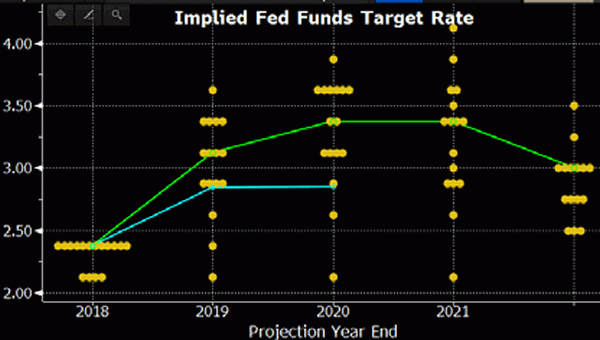- Fed hikes policy rate by 25 bps to 2%-2.25%
- New dot plot aligns 2021 median with 2020 at 3.25%-3.50%
- Growth and inflation assessment broadly unchanged
- Committee drops reference to accommodative policy
- Muted reaction; markets remain more dovish than FOMC forecasts
The Fed hiked its policy rate as widely anticipated by 25 bps from 1.75%-2% to 2%-2.25%. The decision was unanimous. The median rate projections for the 2018-2020 period remained unchanged from June, hinting at one additional rate hike this year (2.25%-2.50%), followed by three rate hikes next year (3%-3.25%) and another (final) one in 2020 (3.25%-3.50%). The median of the first projections for policy rates in 2021 suggests a stabilization (3.25%-3.50%), but the dispersion of forecasts is rather large. Freshly sworn in vice chair Clarida had a decisive vote to determine the median of the neutral rate forecast and tilted the balance from 2.875% to 3%. The balance sheet run-off ($50bn/month from Q4 2018 onwards) goes according to plan. The balance sheet by and large declined from $4.5tn to $4.2bn since Q4 2017.
Policy no longer ‘accommodative’
The FOMC statement was a copy of the August one apart from the Committee dropping a reference to the ‘accommodative’ character of the policy stance. Fed chair Powell stressed that this doesn’t mean that the Fed will be more reluctant to hike rates going forward. He referred to the lower bound of the Committee’s projections for the neutral rate which is 2.5%. Monetary policy actually remains stimulative for the US economy even if the Fed no longer spells it out. Cutting the sentence is more a way to move away from from providing overly precise estimates of inherently uncertain settings. It fits in Powell’s no-nonse style of limiting guidance on monetary policy. He’s more of a rearview mirror looking FOMC president who looks at the current state of the economy and reacts to it by means of the Fed’s monetary policy. The decision also adds evidence to June’s decision to do press conferences after every policy meeting instead of on a quarterly basis (more room to manoever). Is getting rid of the FOMC dot plot what Powell’s got next in mind? On a sidenote, it’s interesting to see the Fed dropping the accommodative language in lockstep with the real Fed Funds target rate turning (marginally) positive for the first time in a decade.
 New Fed dot plot (green) and Fed Funds future curve (blue): unchanged in 2018-2020. Increase neutral rate projection. Source: Bloomberg
New Fed dot plot (green) and Fed Funds future curve (blue): unchanged in 2018-2020. Increase neutral rate projection. Source: Bloomberg
Returning to the statement, the Fed says, as it did in August, that the labor market has continued to strengthen, economic activity has been rising at a strong rate and the unemployment rate has stayed low. (Core) inflation is expected to remain close to the 2% target on a 12-month basis. This setting warrants a continuation of the gradual rate hike cycle, especially as risks to the economic outlook still appear to be roughly balanced. There’s no reference whatsoever to the escalated trade tensions with the US’s main trading partners.
Crunching the new economic and inflationary forecasts brings no new insights. GDP projections for this year and next showed an upward revision, adapting to current US eco strength. The Fed expects growth to hit 3.1% in 2018 (up from 2.8%) and 2.5% in 2019 (up from 2.4%). The 2020 forecast is unchanged at 2%, with the Fed pencilling in a further gradual slowdown of the economy to 1.8% in 2021, in line with longer run trend growth forecast. The FOMC predicts an unemployment rate below NAIRU (4.5%) throughout the 2018-2021 period (3.5%-3.7%). Both headline and core inflation hover slightly above the Fed’s 2% target throughout the forecasting period.
Returning one final time to the new Fed dot plot, we find (very) small evidence that FOMC governors expect 2020 to be the turning point in the economic/Fed cycle. The median FOMC forecast in 2020 was unchanged from June at 3.375%, but the average prediction fell from 3.31% to 3.24%. Second, the median September rate forecast is both 3.375% in 2020 and 2021, but the average declines from 3.24% to 3.17%. We know it’s just splitting hairs and as Fed Chair Powell at his press conference said himself ‘2021 is still a long way from here’. However, we’ll keep monitoring these developments closely in December.
Muted market reaction
The FOMC meeting went more or less in line with market expectations. The US yield curve increased rather significantly in the run-up to the meeting, explaining the buy-the-rumour, sell-the-fact reaction. US yields declined by 2.4 bps (2-yr) to 5.1 bps (7-yr). The decisions don’t stroke with our scenario of a technical break beyond 3.12% resistance of the US 10-yr yield in Q4 2018. The dollar showed some volatitlity around Powell’s press conference, but eventually closed unchanged. The trade-weighted greenback ended 0.11% above Tuesday’s close. EUR/USD closed at 1.1739, down from 1.1767. We maintain our positive bias for the US currency as well. US stock markets gave away intraday gains, to be down 0.2% to 0.4% at the bell, perhaps shaken by the prospect of positive real yields.
The market implied probability of a December rate hike increased only marginally to 77.5% even if 12 out of 16 governors indicated that scenario as preferential. The probability of three more consecutive rate hikes between now and June 2018, our preferred scenario, stands at 26%. We think that the Fed might at that stage (neutral rate) reevaluate its options, though we strongly feel for a continuation of the tightening cycle in H2 2019 as well. Markets remain more dovish than the Fed, attaching a stronger change to 2 additional hikes between now and June next year (42%). The market implied probability of 1 additional hike over that period amounts to 24%.












